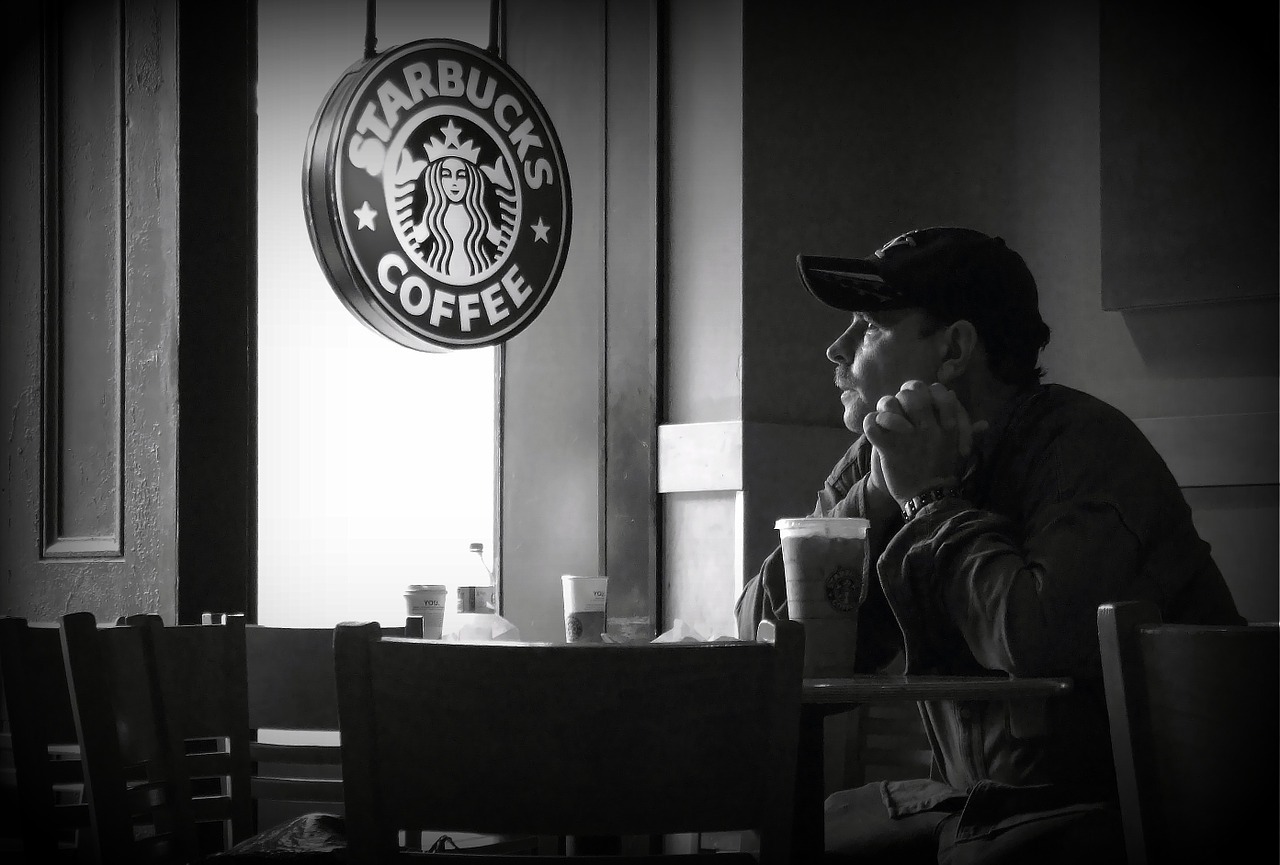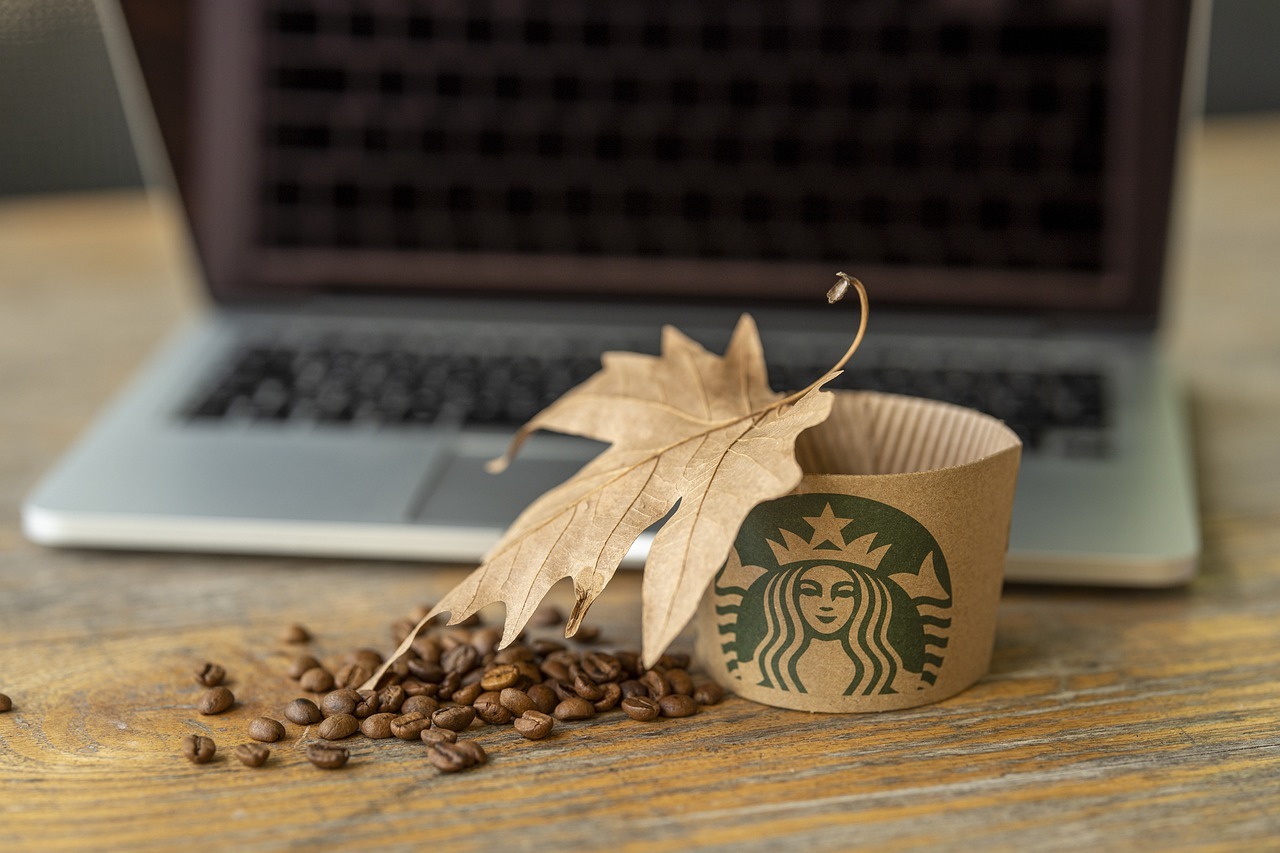Starbucks – multinational cooperation is leading the coffee industry globally. Famous for its freshly roasted hot coffee drinks and Frappuccino, this coffeehouse chain also serves its customers with roasted coffee beans, premium teas, fresh food, and coffee-related merchandise. For decades Starbucks has stood strong and accomplished a lot in forty-nine years. So let us have a look at the history and milestones achieved by Starbucks throughout its existence.
The Initial Years
A man sitting inside a Starbucks café:
In 1971, the first store of Starbucks opened its doors to the public in Seattle’s Pike Place Market. Zev Siegl, Gordon Bowker, and Jerry Baldwin were the three founders of the company who wanted to make a difference and serve something unique to their customers. Initially, for ten years Starbucks just served freshly roasted whole coffee beans, tea and spices to the public. These finest-quality beans clicked with the customers and the business was good. To start off, Starbucks used the coffee beans provided by Berkeley based gourmet coffee company ‘Peets’. Later on, the founders experimented with their own flavors and blends.
Back in the day, coffee was exported from one country to another through the sea voyages. The three founders were fascinated and inspired by the sea adventures and travels of the coffee merchants who imported these coffee beans via the ocean. Also, the founders settled on the name ‘Starbucks’ – inspired by a character named Starbuck in the classical novel Moby Dick. Starbuck – the character in the novel was loyal, practical, and ethical. These are the characteristics on which the founding fathers built their company’s core values and culture.
1982 was the year Starbucks started to sell brewed coffee to its customers for the first time. Another key person Howard Schultz joined the team as the director of operations and marketing. It is after Howard’s joining that Starbucks flourished and made incredible growth as a business. 1982 also marks the year when Starbucks started to supply its coffee beans to bars and fine dining restaurants.
It was during his official visit to the trade fair in Milan in 1983 that Howard Schultz was impressed by the local coffee houses, cafes and espresso bars. He liked the idea so much that he wanted to introduce a similar “coffeehouse” concept back home in Seattle for Starbucks.
A “coffeehouse” is a place that focuses on selling unique coffee drinks (hot/cold) and other refreshments like smoothies, teas, sandwiches, pastries, and other food items. What stands out about a coffeehouse is its environment. With music playing in the background and decorated with comfy sofas and seating, a coffeehouse is a place to relax, lounge, and socialize with friends.
Howard Schultz presented a similar business plan to other board of directors upon his return from Milan. This coffeehouse concept was what Howard Schultz was fighting for but no one saw his vision at that time. He wanted Starbucks to be more than just selling coffee beans and spices. However, nobody seemed to agree with the new idea – well initially they didn’t
By 1984 Howard had convinced other members of the board for a coffeehouse concept and this is when Starbucks served its first cup of on-the-go lattes and coffees. This experiment was a success and the stepping stone laid by Howard Schultz of the Starbucks we all know today.
Howard Schultz quickly realized that the other board members were skeptical about his coffeehouse concept for the business and not willing to experiment. In 1985 Howard Schultz left Starbucks and opened his own coffee house ‘Il Giornale’ offering freshly brewed coffees and espressos. His business was an immediate success and expanded quickly.
1987 is when the founders of Starbucks decided to sell the company and Howard Schultz purchased it. He quickly rebranded his business as Starbucks Corporation and opened stores in Chicago, Columbia, and Canada.
The Years of Growth and Expansion
Busy coffee shop:
In 1991 – Starbucks expanded its reach and opened its very first licensed airport store at Seattle’s Sea‐Tac International Airport.
By 1992 the company goes public and completes initial public offering (IPO). This is also the year where Starbuck comes out as being environmentally responsible and reveals its mission statement pledging to “a role of environmental leadership in all facets of our business.” They describe themselves as a company that “strikes a balance between profitability and a social conscience.”
1993 is when Starbucks opened its very own roasting plant in Kent and in 1994 opened its first-ever drive-through location. 1995 marks the year when the coffee guru started serving Frappuccino – blended beverages. This is also the year when the company opened its first LEED-certified store.
1996 was a pivotal year for the company. This is when Starbucks made a global impact and expansion. In 1996 they opened their first international coffeehouse – in Tokyo Japan, which was a huge success.
By 1997 the company made another great move and introduced its brand into the grocery stores selling ready-to-drink bottled Starbucks Frappuccino and coffee beans
Health and Environment Conscious
Coffee beans, cup, and a leaf:
Offering healthy drinks/food and recyclable materials becomes Starbucks’ passion. In 1997 Starbucks introduced its first non-dairy milk alternative – soymilk. Starbucks initiates its first ethical sourcing program in partnership with Conservation International in 1998.
By the time they reach 2007, not only does Starbucks had successfully managed to eliminate all “artificial trans-fat and make 2 percent milk the new standard for espresso beverages.”, but also accomplished to introduce the industry’s first hot beverage paper cup.
In 2009, Starbucks opened its first Opens LEED-certified roasting plant in Sandy Run, S.C. This is also the time the company starts going digital and launches its very own apps and mobile payment. By 2010, the coffeehouse offers free Wi-Fi facilities to its customers
2015 marks another achievement by Starbucks. The company starts a subscription program in the U.S. letting its customers order high-end coffee beans made at Starbucks’ premises from the comforts of their homes. By this time, Starbucks has also managed to source 99% of its coffee ethically in partnership with Conservation International. Not only that, but Starbucks also introduces fresh handcrafted smoothies and cold brew iced coffees.
2017 marks the end of an Era. This is the year CEO Howard Schultz steps down from his position to concentrate on other businesses of the Starbucks Cooperation. Up until then, the Starbucks franchise was booming in 75 countries.
By 2018, Starbucks is working hard to save the environment. It removes the usage of plastic straws in all its stores in Korea, invests in a solar plant, donates 2million coffee seeds to help build Puerto Rico’s deteriorating coffee industry and commits to abolish the use of plastic straws globally by 2020. There is no doubt they also use the best coffee makers as well.
Today Starbucks has over 27,000 stores worldwide and currently serves over 30 blends of premium coffees rich in flavors. The company’s continuous efforts to be better, achieve new goals and caring for the environment assures that Starbucks is here to stay for many more years to come.



